Read and learn about Slovak wildlife in Tatras

One of the extraordinary facts about the High Tatras is that people live in a tight connection with animals.
Those are their neighbours, their friends, guardians, followers and sometimes also, sadly, enemies.
In the villages, the closer they get the less shy they are, which is usually very risky. However, at higher altitudes, true wildlife can be experienced.
As you hike towards the peaks, vegetation zones with fauna change.
We will start with broadleaved and mixed forests up to the spruce forests (up to app. 1.550 metres above sea level) where bears, wolves, lynx and deer could be found, continue with mountain pine zone (up to 1.800 metres above sea level) gradually changing into alpine meadows which are home to chamois and marmots (up to 2.300 metres above sea level) ending with bare inhospitable peaks (up to 2.600 metres above sea level).
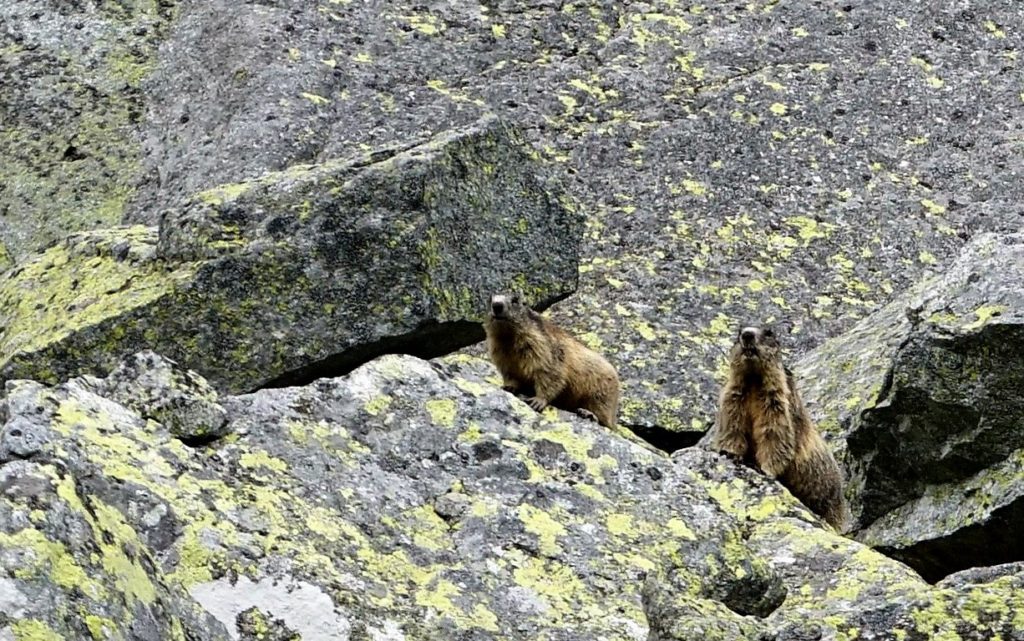
Some of the animals could be found all over Slovakia or Europe in the similar climates and some of them are endemic. All of them are strictly protected as their numbers are very unstable and lots of them are endangered.
You can read this blog to get to know the ‘celebrities’ of the High Tatras and to be aware who to await on the trails or who to look for with binoculars.
Red deer – Jeleň lesný – Cervus elaphus
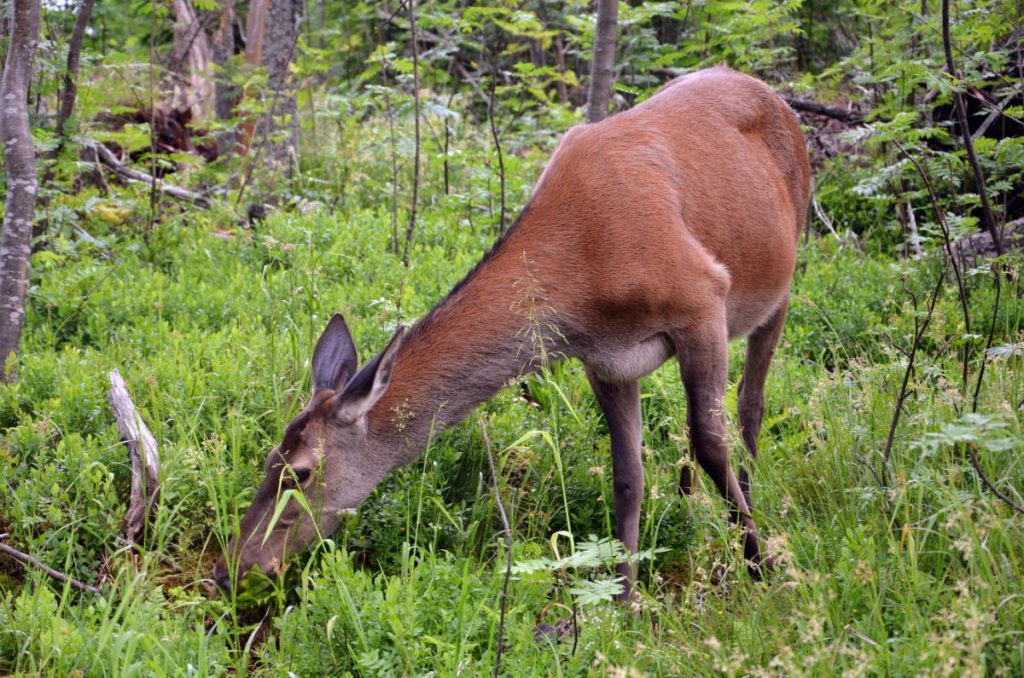
Red deer is an even-toed ungulate animal which could be found all over Europe.
Out of these mountainous animals, deer is the least endangered. Male deer is 170-230 cm tall and has weigh up to 500 kilograms. Females are visibly smaller. Due to their size, they have almost no predators.
Sometimes wolves, sometimes bears can hunt them, but males fight with their antlers (they use them also while fighting for female deer) and females are alert and can warn herd by special signal.
Antlers are a characteristic feature of male deer. Annually, at the end of winter, they used to shed the antlers as during spring they grow back.
Whereas antler is formed from bone tissue, horn is a skin derivative. Every day, the antler can grow 2.5 cm to length. Adult deer has got also several tines which show how old the deer is.
Deer is socially similar to bear. While males use to live as loners, except of the period of mating, females live in herd which can consist of 50 heads. Mating is connected with rut when males try to attract females by loud roaring. Female give birth usually to one, rarely to two calves.
Deer can be easily met in dawn and dusk when it is the most active and grazes and hence it is quite dangerous to drive fast along meadows. Deer is an herbivore and eats mainly herbs, berries, beechnuts, chestnuts, acorns and buds.
Lynx – Rys ostrovid – Lynx lynx
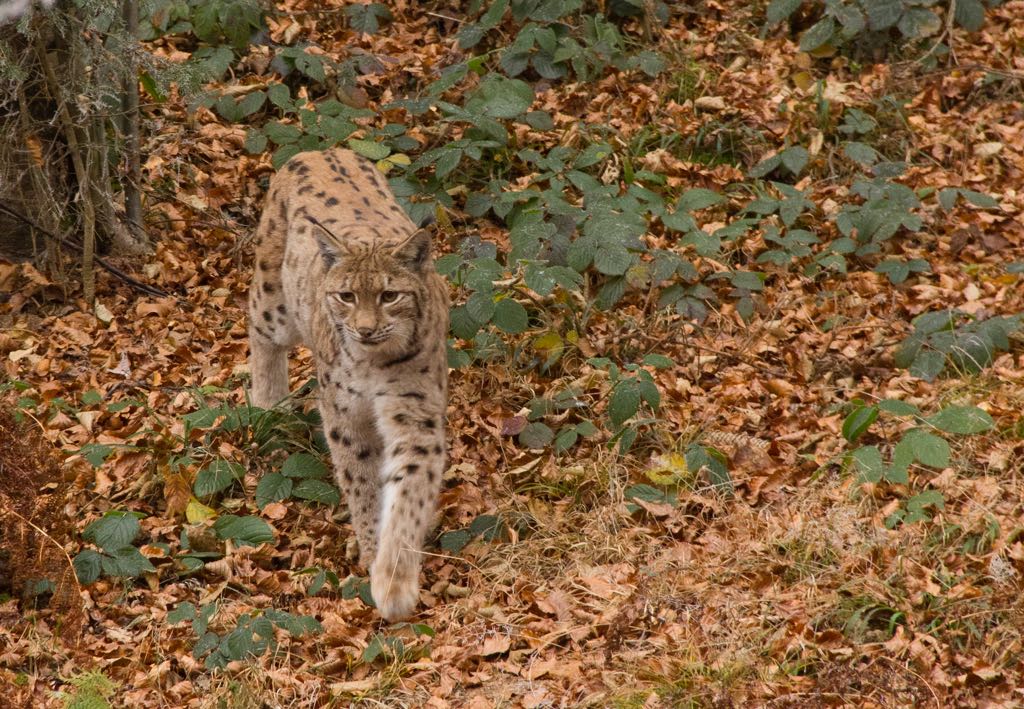
Lynx is a feline that hunts small and weak hoofed animals. Thanks to his sight, which is flawless, it is called ‘the one with sharp sight’. It can recognize rodent from 75 metres and deer from 500 metres. Lynx is a predator and is active mainly during the night. During days it likes to bask in the sun in meadows or hide in rocky hollows and bushes.
Adult male can grow up to 70 cm and length of 130 cm and weighs up to 30 kilograms. Lynx is known for its triangular ears with black hairy endings and also black ending of its tail. Colour of their fur differs from grey, yellowish, reddish and brown with dark spots.
Lynx is a loner. Only during period of mating, several males meet and fight for female. This period is set to February and March and in 10 weeks females give birth to 2-4 cubs.
They stay with mother until the next mating. Male lynx marks its territory with excrements and urine and protects it against enemies. Whereas male territories do not overlap, they can overlap with female ones.
Grey wolf – Vlk dravý, sivý – Canis lupus
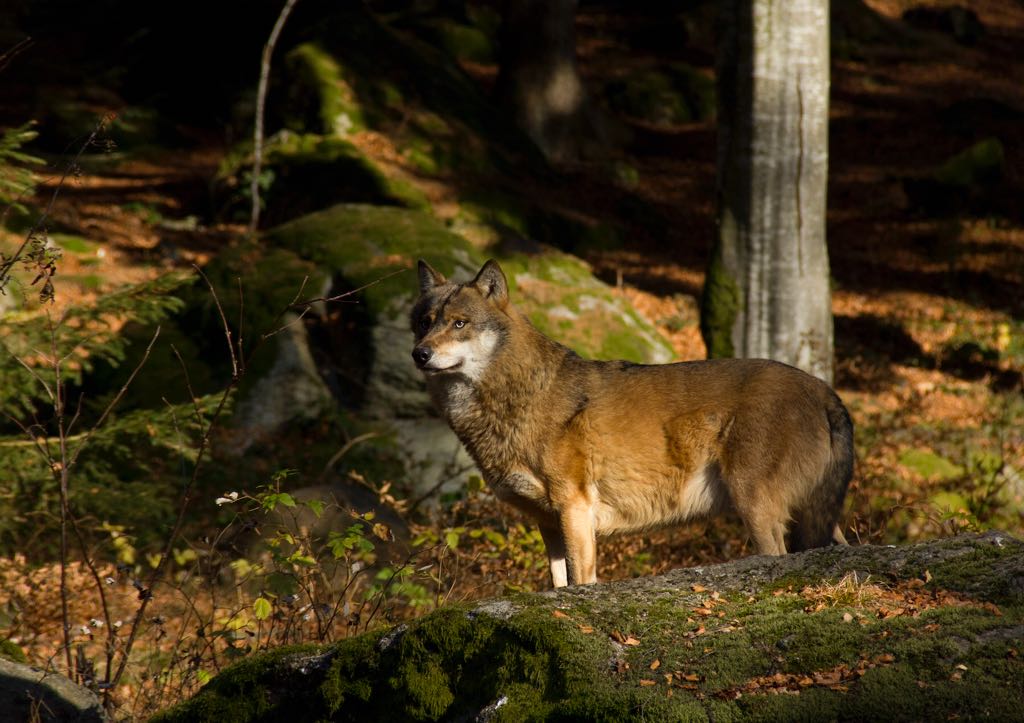
Wolf is a strong predator and the biggest canine. It weighs up to 80 kilograms and is up to 90 cm tall.
It is a social animal and lives in a pack. Packs have a strong hierarchy, from Alfa to omega. There is an Alfa pair that leads the pack, eats first and is superior to others.
Furthermore, no other wolves except the Alfa pair can keep their cubs. Those are excluded from the pack and must create another one. Pack is important also for hunting. Wolves have their strategy and wait for the prey to exhaust and after that they kill it.
Although the grey wolf is dangerous, it is also very shy. However, as other animals, it gradually gets used to people and hence hunts farming animals. It benefits from its great smell and hearing. In open space, it can smell up to 3 km and hear up to 8 km. Its sight is also very good, although wolves focus on movement and hence can miss static object. Therefore, its prey usually sees more and is prepared better.
Brown bear – Medveď hnedý – Ursus arctos
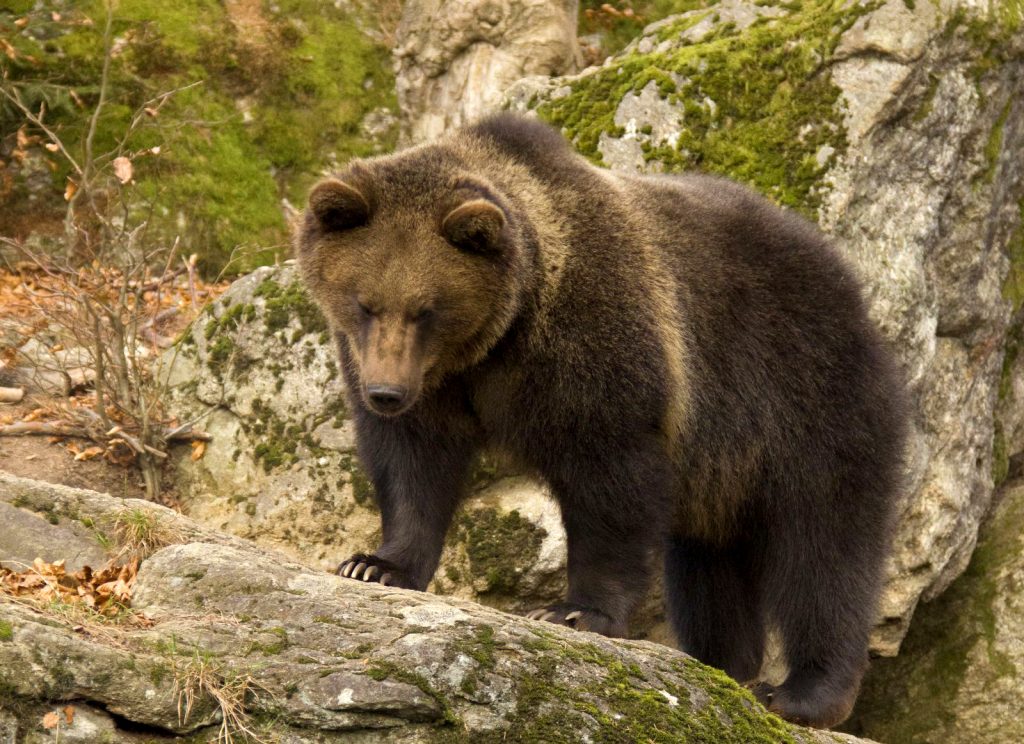
Bears hibernate during winter for 6 months and thus this period ends at the end of February and beginning of March. During this period, females usually give birth to cubs.
In spring period, male bears walk over their territories which are marked with bites on the tree trunks and stuck fur on bark. These trees could be hence easily called ‘bear trees’.
You may like our bearwatching zour on this link
Although they are less movable, they are more active in spring, mainly at night – they cross large areas and could come down to villages as they got used to food leftovers.
Male bears are loners, whereas females protect and teach cubs. Bears are omnivorous; they eat fruit – blueberries and raspberries, can dig up roots and tubers, and also larva, insects, frogs, snakes, various rodents and mostly after winter carcasses stuck in the snow or killed by other predators.
Concerning size, bears grow up to 3 m and 350 kilograms. Female with its cubs is more dangerous as it protects them.
Tatra chamois – Kamzík vrchovský tatranský – Rupicapra rupicapra tatrica
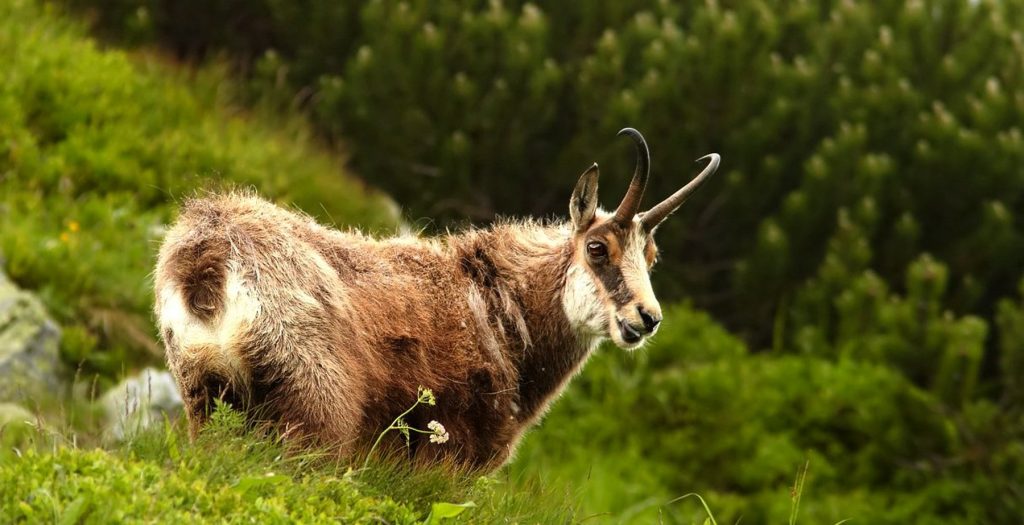
Tatra chamois is an endemic animal in the NP High Tatras and NP Low Tatras. However, it was intentionally released in this park as the population in the High Tatras fell down rapidly in the 2nd half of the 20th century.
This animal is literally like an alpine goat. It lives in the higher altitude and is used to steep and rocky terrain, to snow in winter. Chamois eats herbs and lichen; it grazes in the alpine meadows. Concerning size, it is a smaller hoofed animal.
Adult male chamois weighs up to 50 kg and is up to 70 cm tall, females are a bit smaller. However, both males and females have little goatlike horns that are bended backwards.
To look inconspicuously, chamois has got brown fur and only its face is white with characteristic dark stripes below eyes and white bottom.
Chamois is a very social animal and hence lives in a flock. Period of rut is set to November, early December and is characterized with males fighting for females.
At the end of the spring, females give birth usually to one calf, after 20 weeks of gravidity. Chamois lives usually for 20 years. As deer, males use to live alone throughout the whole year, while females with claves stay in a flock.
Alpine marmot – Svišť vrchovský tatranský – Marmota marmota latirostris
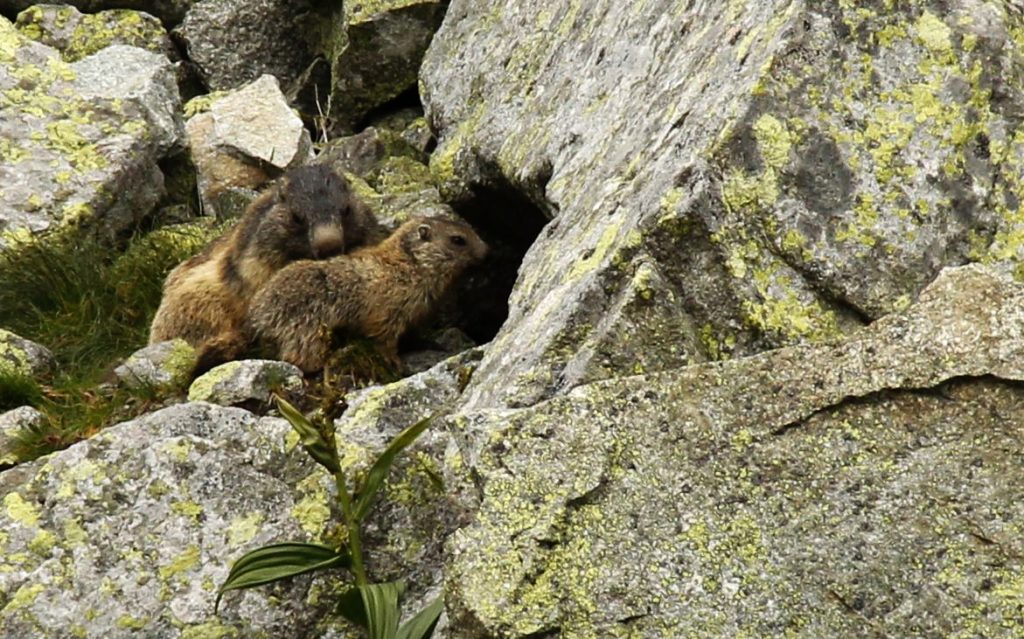
Marmot is a big rodent and together with chamois it belongs to a group of endemic animals. Its fur is a mix of grey, brown and yellowish. However, males and females look almost the same.
Adult male weighs up to 8 kilograms and is up to 90 cm long plus 15 cm long tail. This weigh is characteristic for the end of summer period as marmots must prepare for hibernation, which lasts 6-7 months.
During whole summer they create fat reserves. They eat herbs, grains, insects, spiders or worms and feed themselves usually in the morning and late afternoon when it is not that hot. Fat forms one third of their weight. During winter, their temperature falls to 4°C and heartbeat to 5 times per minute.
Period of mating is set to spring after burrowing themselves up from beneath snow. After approximately one month, females give birth to 1-7 animals, usually 3. Marmots can live for 15 years.
Like chamois, marmot is also a social animal but their groups are called colonies. They consist of 5-15 marmots living in burrows that have been dug with their sharp claws and teeth. Burrows serve for living, keeping offspring and protecting themselves against enemies and sun. Tunnels are used as toilets.
Both marmots and chamois live in the zone of alpine meadows and rocky areas above mountain pine zone. Although marmots are rather inconspicuous, their whistle is a characteristic element of the High Tatras.
If you liked our wildlife blog share it please or join one of our tours, thank you!